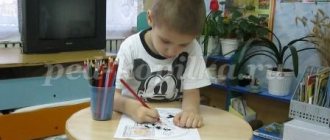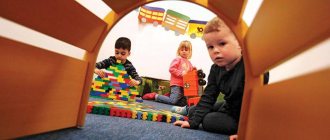Theatrical activities in preschool educational institutions in accordance with the Federal State Educational Standard
YULIA ONASHVILI
Theatrical activities in preschool educational institutions in accordance with the Federal State Educational Standard
Theatrical activities in preschool educational institutions in accordance with the Federal State Educational Standard.
Why theatrical activities?
This is one of the most effective ways to influence children, in which the principle of learning is most fully and clearly demonstrated: learn by playing.
It is known that children love to play; they should not be forced to do so. While playing, we communicate with children on “their territory.” By entering the world of play, we can learn a lot ourselves and teach our children. And the words spoken by the German psychologist Karl Gross are relevant in this regard: “We play not because we are children, but childhood itself is given to us so that we can play.”
The founder of the Moscow Puppet Theater S.V. Obraztsov once expressed the idea that every child has a natural desire for acting.
And we know that acquaintance with the theater occurs in an atmosphere of magic, festivity, and high spirits, so it is not difficult to interest children in the theater.
In the context of the transition to the Federal State Educational Standard for Preschool Education, one of the main principles of preschool education reflected in the Standard is:
“Implementation of the Program in forms specific to children of this age group, primarily in the form of play, cognitive and research activities, in the form of creative activity that ensures the artistic and aesthetic development of the child.”
Theatrical activities in kindergarten are an excellent opportunity to reveal the creative potential of a child and foster the creative orientation of the individual.
Using theatrical activities in the system of educating children in preschool educational institutions, we solve a set of interrelated problems in all educational areas according to the Federal State Educational Standard for Preschool Education:
Social and communicative development
• formation of positive relationships between children in the process of joint activities;
• fostering a culture of knowledge in adults and children (emotional states, personal qualities, assessment of actions, etc.);
instilling in the child self-respect and a conscious attitude towards his activities;
• development of emotions;
• education of ethically valuable ways of communication in accordance with the norms and rules of life in society.
Cognitive development
• development of diverse ideas about reality (different types of theater, professions of people creating the performance);
• observation of natural phenomena, animal behavior (to be conveyed by symbolic means in a dramatization game);
• ensuring the relationship between construction and theatrical play for the development of dynamic spatial concepts;
• memory development, learning the ability to plan your actions to achieve results.
Speech development
• promoting the development of monologue and dialogic speech;
• enrichment of the vocabulary: figurative expressions, comparisons, epithets, synonyms, antonyms, etc.;
• mastering expressive means of communication: verbal (regulation of tempo, volume, pronunciation, intonation, etc.) and non-verbal (facial expressions, pantomime, postures, gestures);
Artistic and aesthetic development
• introduction to highly artistic literature, music, folklore;
• development of imagination;
• involvement in joint design activities on modeling costume elements, scenery, attributes;
• creation of an expressive artistic image;
• formation of elementary ideas about types of art;
• implementation of independent creative activities of children.
Physical development
• coordination of actions and accompanying speech;
• the ability to embody the mood, character and process of image development in a creative movement;
• expressiveness of execution of basic types of movements;
• development of general and fine motor skills: coordination of movements, fine motor skills of the hand, relief of muscle tension, formation of correct posture.
System of work for organizing theatrical activities:
1. Subject-spatial development environment
2. Long-term planning and implementation: theater classes, theatrical performances, entertainment, project activities.
3. Interaction with teachers
4. Working with children
5. Interaction with parents
6. Interaction with society
Therefore, when designing a subject-spatial environment that provides theatrical activities for children, we take into account:
• subject-spatial environment is the basis for the independent creativity of each child.
• adherence to the principles of building a developmental gaming environment
• compliance with the age characteristics of children
• compliance with safety regulations
• aesthetic design of gaming equipment
Theatrical activities in kindergarten can be included, in accordance with the Federal State Educational Standard, in educational activities carried out in the process of organizing various types of children's activities (game, communicative, musical and artistic, etc.); educational activities carried out during regime moments; independent activities of children.
The content of work with children on theatrical activities includes:
Diction exercises (articulation gymnastics);
Tasks for the development of speech intonation expressiveness;
Transformation games, imaginative exercises;
Exercises for the development of children's plasticity;
Rhythmic minutes;
Finger play training;
Exercises to develop expressive facial expressions, elements of pantomime;
Theater sketches;
Acting out mini-dialogues, nursery rhymes, songs, poems;
Watching puppet shows.
Basic requirements for organizing theatrical games
• Content and variety of topics.
• Constant, daily inclusion of theatrical games in all forms of the pedagogical process.
• Maximum activity of children during the stages of both preparation and play.
• Cooperation of children with each other and with adults at all stages of organizing a theatrical game.
• The sequence and complexity of the content of the themes and plots chosen for the games correspond to the age and skills of the children.
Interaction with teachers
The effective work of the institution for theatrical activities of children is facilitated by a professional teaching staff.
Work to improve pedagogical skills is carried out in several directions:
• Advanced training as part of course training.
• Improving the qualifications of teachers in theatrical activities within a preschool institution through methodological events and pedagogical advice.
Results of the work of the preschool educational institution:
Children master expressive speech skills, rules of behavior, etiquette for communicating with peers and adults.
Show interest and desire for theatrical art.
They are able to convey various feelings using facial expressions, gestures, and intonation.
They independently perform and convey images of fairy-tale characters.
Children try to feel confident during performances.
The subject-spatial developmental environment of the preschool educational institution was supplemented with different types of theaters, manuals, drawings, and card files of creative games.
Close contact has been established with parents.
When we engage in theater with children, we set ourselves the goal of making our children’s lives interesting and meaningful, filling it with vivid impressions, interesting activities, and the joy of creativity. We strive to ensure that children can use the skills acquired in theatrical activities in everyday life.
From all of the above, we can conclude that we are on the right path and, on the basis of theatrical activities, it is possible to realize almost all the tasks of raising, developing and teaching children.
Preparatory group. Senior preschool age. Children 6-7 years old
Abstract of the open NOD “Theatricalization based on the fairy tale “Kolobok” with elements of logorhythmics” for children 6–7 years old with level 3 ODD. Open abstract (NOD)
classes “
Theatricalization based on the fairy tale Kolobok with elements of logorhythmics” for children 6-7 years old with speech development disorder (SPD 3)
Goal: to improve coherent speech in school-preparatory children with SPD through
theatrical activities based on the theatrical ...
“The Puppy Is Missing.” Summary of educational activities for children in the preparatory school group for speech development with elements of theatricalization Topic: “The puppy is missing”
Goal: Compiling a descriptive story in the form of an advertisement on a specific topic. Objectives: Developmental: Develop phonemic hearing, coherent dialogic and monologue speech. Educational: Learn to highlight stress in syllables by ear. Learn to navigate...
Rhythmoplasty
This element is necessarily included in the program for theatrical activities in the preschool educational institution Federal State Educational Standard. The essence of rhythmoplasty is a set of musical, rhythmic, plastic exercises and games that are designed to develop the natural psychomotor abilities of preschoolers. Thanks to such exercises, theatrical activities within the framework of the Federal State Educational Standard become bright and rich.
Children acquire the skills of expressive body movements and feel harmony with the world around them.
The main goal of introducing rhythmoplasty into preschool educational institutions is to develop the skill of voluntary response to musical sounds and the teacher’s signal. Gradually, children develop coordination of movements, remember certain poses, and learn to convey them using images and facial expressions.
Main areas of work
Costume play is a phenomenon with deep historical roots. Currently, it has become an independent type of activity characteristic of humans.
Theatrical activities according to the Federal State Educational Standard in preschool educational institutions contribute to solving the following tasks:
- teaching preschoolers spatial orientation skills;
- building a dialogue on a specific topic;
- voluntary tension and relaxation of individual muscle groups;
- memorizing texts (auditory and visual memory);
- observation;
- figurative thinking.
There are several techniques that help instill in preschoolers an interest in the performing arts.
Significance of the work
Theatrical activities according to the Federal State Educational Standard in preschool educational institutions help the teacher to raise active and bright personalities. Children learn to see unusual details in the world around them and create artistic images based on them.
Theatrical activities according to the Federal State Educational Standard in preschool educational institutions contribute to the formation of associative thinking in children. By trying themselves in different roles, children overcome shyness and self-doubt, become more relaxed and open to communication with peers.
Peculiarities
Theatrical activities in preschool educational institutions in accordance with the Federal State Educational Standard are aimed at solving the following important issues:
- formation of the correct model of children’s behavior in modern conditions;
- improving the general culture of preschool children, introducing them to spiritual and moral values;
- improving children's speech, activating vocabulary, improving the sound culture of speech, intonation structure, improving dialogue;
- introducing preschoolers to children's music, works of art, rules of behavior at the table (at a party), folk traditions;
- instilling cognitive interest in theatrical art;
- improving emotional experiences, encouraging imaginative thinking.
The use of theatrical scenarios in the classroom helps the teacher develop creative collaboration and public speaking skills in preschoolers.
Culture and technique of speech
These elements must be included by the teacher in his plan. Theatrical activities in preschool educational institutions in accordance with the Federal State Educational Standard are aimed specifically at the development of correct articulation and speech breathing. Children acquire clear diction, learn to independently compose short fairy tales and stories, select poetic rhymes, pronounce tongue twisters, and read poetry with intonation. Involving preschoolers in theatrical activities helps to replenish their vocabulary and improve their communication skills.
An analysis of theatrical activities in preschool educational institutions according to the Federal State Educational Standard involves a comparison of initial skills and abilities with those that a child acquires (develops) with the help of art.



